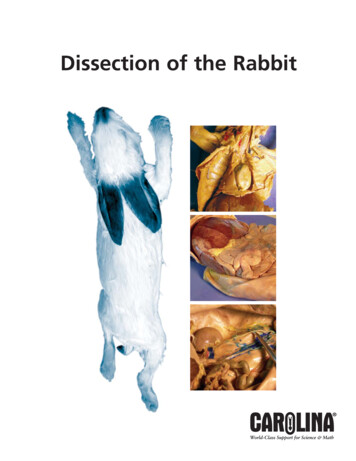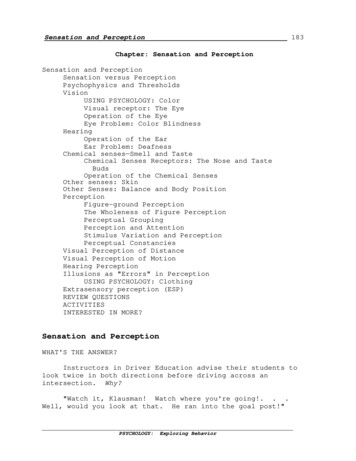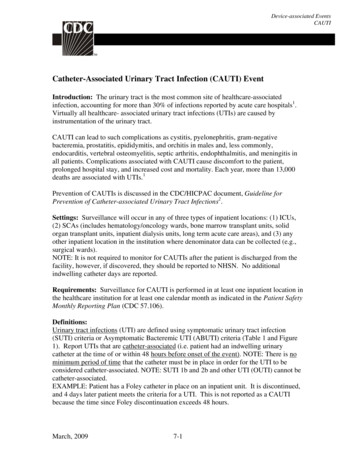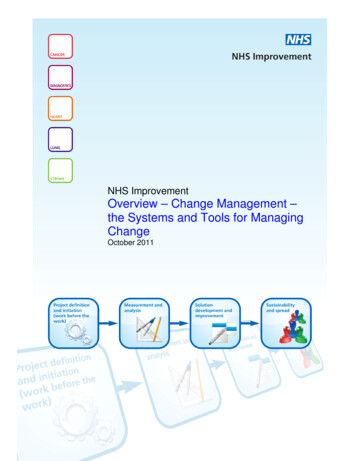
Transcription
ClinicalPracticeTaste Change Associated with a Dental Procedure:Case Report and Review of the LiteratureContact AuthorGary D. Klasser, DMD; Robert Utsman, DDS; Joel B. Epstein, DMD, MSD, FRCD(C)Dr. KlasserEmail: gklasser@uic.eduABSTRACTLoss or alteration of taste is a rare phenomenon that may be idiopathic or may be causedby head trauma, medication use or systemic and local factors including various invasivedental procedures resulting in nerve damage. We present an unusual case of generalized taste change following an oral surgical procedure. The case is presented to enhanceunderstanding of taste disorders and their relation to a localized traumatic event.Causative factors and management strategies are also reviewed.For citation purposes, the electronic version is the definitive version of this article: www.cda-adc.ca/jcda/vol-74/issue-5/455.htmlTaste change, encompassing loss (ageusia)or alteration (dysgeusia) of taste, is a rarephenomenon that may be idiopathic ormay result from head trauma; endocrine,metabolic, sinus, autoimmune and salivarygland disorders; medication use; cancer treatment (radiation or chemotherapy); viral,bacterial and fungal infections; certain oralconditions; or peripheral nerve damage due toinvasive procedures including dental interventions.1–4 Some factors thought to be responsible for nerve injuries associated with dentalprocedures are proximity of the chorda tympani nerve to the surgical site, retraction ofthe lingual flap, extraction of unerupted teeth,especially third mandibular molars, and experience of the operator. 5–9 Nerve damage mayalso be a result of local anesthetic injectiondue to direct needle trauma causing hemorrhage within the epineurium or a neurotoxiceffect of the anesthetic.10,11The sensation of taste is mediated by 3 cranial nerves: facial (VII), glossopharyngeal (IX)and vagus (X).12 The trigeminal nerve (V) provides general sensory innervation to a regionthat overlaps the areas served by these othercranial nerves12 (Table 1). Because of theiranatomic proximity, the possibility exists foriatrogenic injury to the chorda tympani, lingual nerve or both during surgical proceduresin the posterior mandible. This may result inirreversible gustatory deficits and somatosensory dysfunction.13,14The purpose of this article is to review thepossible causes and management of taste disorders. An unusual case of generalized tastechange following an oral surgical procedure ispresented to enhance understanding of tastedisorders and their possible relation to a localized traumatic event.Case ReportIn October 2006, a 66-year-old man presented to the oral medicine clinic with thechief complaint of taste change. In addition,he reported a sensation of oral dryness despitefrequent hydration with water, poor appetiteand malaise. He had lost approximately 10pounds since the onset of his poor appetite inJuly 2005. His taste loss had occurred severalJCDA www.cda-adc.ca/jcda June 2008, Vol. 74, No. 5 455
––– Klasser –––Table 1 Cranial nerves and branches involved in tasteCranial nerveLocation ofexit from skullBranchesInnervated area related to taste functionMandibular (V3),a branch of thetrigeminal nerveForamen ovaleLingual nerveGeneral sensation on the anterior two thirds oftongueFacial (VII)Internal auditorymeatusChorda tympaninerveGreater superficialpetrosal nerveSensation of taste on the anterior two thirds oftongueSensation of taste on the palateGlossopharyngeal (IX)Jugular foramenLingual branchSensation of taste on the posterior third of tongueGeneral sensation on the posterior third of tongue,oropharynx and pharyngeal mucosaVagus (X)Jugular foramenPalatopharyngealbranchSensation of taste on the base of tongue andepiglottisGeneral sensation on the soft palate and upperlarynxFigure 1: Preoperative panoramic radiograph showing advancedperiodontal bone loss.weeks after a combined periodontal and oral surgeryprocedure.The procedure had been recommended by his periodontist due to advanced periodontal bone loss and associated tooth mobility (Fig. 1). Performed by an oralsurgeon in July 2005 under intravenous sedation, theprocedure involved the extraction of his maxillary andmandibular third molars. Surgical incisions involving thesulcular, buccal, lingual and palatal tissues in both themaxillary and mandibular posterior regions were carriedout to allow access for thorough debridement and recontouring of the residual osseous defects in these areas. Thepatient was prescribed analgesics that are used routinelyduring postsurgical recovery.Between August and December 2005, the patient returned several times to the oral surgeon to report hissymptoms. The surgeon noted his complaint of taste456change, but did not provide any treatment. In October2005, the patient sought treatment from his primary carephysician. At that time, he stated that food “tasted likecardboard” since the dental procedures. The physicianconducted provocation taste tests, placing sugar, salt andmustard on the patient’s tongue. The patient did not detect salt or mustard, resulting in a diagnosis of ageusia/dysgeusia and subsequent referral to a neurologist.The patient returned to his physician many times withhis complaint of taste change; however, he did not complete the neurology consult. In June 2006, the physicianordered magnetic resonance imaging (MRI), but no central nervous system lesions or extra-axial abnormalitieswere detected.At his initial examination at the oral medicine clinicin October 2006, the patient reported that he was ableto discern different tastes, although at reduced intensities (hypogeusia), and he often experienced loss of tasteduring mastication. The patient self-medicated with zincsupplements (50 mg 4 times a day) but had not noticedany improvement in taste intensity or alteration in frequency of ageusic episodes.In December 2005, the patient had been diagnosedwith hypothyroidism and prescribed thyroid supplementation. He also reported osteoarthritic knees and hadtaken an over-the-counter joint supplement, but discontinued its use following our initial appointment. He wastaking multivitamins and minerals and reported an allergy to sulfa drugs.An extraoral examination revealed intact cranialnerves, facial symmetry, no lymphadenopathy, normalrange of mandibular movements and no tenderness orJCDA www.cda-adc.ca/jcda June 2008, Vol. 74, No. 5
––– Taste Change –––Table 2 Conditions and mechanisms resulting in taste changes1–7,10,11,14–17ConditionMechanismTaste alterationHead traumaDamage to central or peripheral nervesDysgeusiaAgeusiaSystemic conditions (diabetes, hypothyroidism, systemic lupus erythematosusand nasal polyps)Alteration in taste receptor function orsignal transductionDecreased salivary flow rateDysgeusiaElevated bitter tasteVarious medications, includingACE inhibitors, calcium-antagonist,diuretics, antiarrythmics, antibiotics,antivirals, antiprotozoals, antirheumatics,antithyroid, antidiabetic, antihistamines,antidepressants, antipsychotics, localanesthetics, antineoplastic treatment,chelating agentsInterference with chemical compositionor flow of salivaSecretion of the medication in salivaAlteration in taste receptor function orsignal transductionHypogeusia (decreasedsensitivity to taste)DysgeusiaAgeusiaRadiation or chemotherapy to treatcancer of the head and neckChanges in salivary compositionDrug secretion in oral fluidsDecreased salivary flow rateAlteration in normal oral floraDecreased rate of turnover of taste budsDysgeusiaAgeusiaViral infections (upper respiratory tractand middle ear, herpes zoster, HIV)Damage to central or peripheral nervesDysgeusiaAgeusiaOral bacterial and fungal infectionsDamage to central or peripheral nervesDecreased salivary flow rateElevated bitter and/ormetallic tasteDysgeusiaOral conditions (lichen planus, burningmouth syndrome and dry mouth)Damage to central or peripheral nervesDecreased salivary flow rateHypogeusiaDysgeusiaLocal anesthetics (articaine, procaine,tetracaine, bupivacaine or lidocaine)Direct needle trauma to nerveHemorrhage inside the urgical proceduresPartial or complete nerve transactionDysgeusiaAgeusiaNote: ACE angiotensin converting enzyme.pain on palpation of the masticatory musculature andlateral aspect of the temporomandibular joints. Intraoralexamination revealed intact dentition with well-healedmucosa at the surgical sites and no clinical signs of infection or inflammation. The oral mucosa and gingivae werewithin normal limits: pink, without lesions, masses orswellings. The tongue was normally papillated and waswithout lesions or masses. Salivary flow rates were determined measuring total saliva (unstimulated and stimulated) expectorated for 3 minutes. The results indicated aslightly reduced unstimulated flow rate (0.2 g/min) and anormal stimulated whole salivary flow rate.The working diagnosis was taste change as a resultof injury to chorda tympani nerves at the time of thesurgery, probably caused by inflammatory, infectious orfibrotic changes within the nerves. There was also thepossibility of an underlying pathosis, leading to tastehypogeusia and mild hyposalivation at rest.Zinc dosage was increased from 200 mg/day to450 mg/day and the patient was prescribed 30 mg cevimeline 3 times a day to increase saliva production.This medication produced subjective improvementand comfort with eating. Objective salivary flow rates(0.5 g/min unstimulated and 1.9 g/min stimulated) indicated an increase in salivary flow. In November 2006,a technetium-99m bone scan was performed to assessand rule out nonclinically evident pathology in thebone; no significant findings were identified. FurtherJCDA www.cda-adc.ca/jcda June 2008, Vol. 74, No. 5 457
––– Klasser –––imaging of the head (computed tomography and MRI)was unremarkable and ruled out central nervous systempathology.Although the patient was satisfied with the increasein intraoral moisture and continues to use sialogogues,normal taste sensation has not returned. He was advisedto discontinue zinc supplements and to modify his dietby increasing the texture of foods and using stronger seasonings. At this point, he is satisfied with the recommendations and will be recalled periodically for follow-up.DiscussionMany reported cases of taste change are idiopathic.2However, many identifiable causes are also associatedwith chemosensory (taste or olfactory) deficits (Table 2).In the case presented, the lack of history of these conditions and the unremarkable clinical examination, bonescan and neuroimaging enabled us to rule out potentialunderlying tumour or other disease entities. At the onsetof the initial complaint, there was no history of medication use or diagnosis of any systemic condition.Several months after the patient reported taste changes,he was diagnosed with hypothyroidism and treated withthyroid supplementation. Several studies18–20 have citedhypothyroidism as a factor that may affect taste becauseof the role of thyroid hormones in the maturation andspecialization of taste buds. However, the timing of thisdiagnosis well after presentation of the initial complaintand the fact that the patient’s hypothyroidism is well controlled makes this an unlikely cause of the taste change.Although gustatory disorders after oral surgical procedures have frequently been reported, much of the literature is based on case studies resulting from damage to thechorda tympani after middle ear surgery.21–24 However,several articles report unilateral taste change, sensory(anesthesia, dysesthesia or paresthesia) changes andnerve damage after surgical procedures involving the removal of third molars.14,15 Shafer and others16 showed thatperceived taste intensity on discrete areas of the tonguewas significantly reduced after third molar surgery, andpatients with the most severely impacted molars gave thelowest taste intensity ratings to whole-mouth test solutions. They also found that removal of severely impactedmolars could cause partial or complete transection ofnerves resulting in gustatory deficits. Surgical proceduresrequiring lingual flaps, tooth sectioning or the insertion of a periosteal elevator can all be linked to tastedysfunction following third molar extraction.5,6 In ourcase, although a surgical procedure to remove the thirdmolars was not conducted, surgery and manipulationof the underlying tissues was performed for periodontalreasons and may have resulted in neural injury and led tothe patient’s complaints.Nerve damage has also been linked to the experienceof the operator and procedures performed under various458forms of sedation. Complications, including a higherfrequency of nerve damage, are more likely with lessexperienced oral surgeons than with more experiencedoral surgeons.7 In addition, the degree of force used to remove impacted teeth is greater when the patient is undersedation than in a conscious patient and this additionalaggressiveness is a risk for nerve damage.17 Although inour case it seems unlikely that a high degree of forcewould be needed to remove his erupted and periodontallycompromised teeth, it is possible that nerve injury mayhave been caused during that procedure.Another possible mechanism for nerve damage is theuse of local anesthetic. Direct contact with the needleused to inject anesthetic traumatizes the nerve and produces a prolonged change in sensation. However, paresiscaused by shearing of the nerve as a result of directtrauma is unlikely because of the small diameter of theneedle (0.45 mm in a 25-gauge needle) compared withthe 2–3 mm diameter of the lingual and inferior alveolarnerves.11,25 Intraneural hematoma caused by the needlestriking one of the smaller intraneural blood vessels is apossible cause of nerve damage. If the needle contactedone of the small blood vessels inside the nerve, the release of blood and blood products inside the epineuriumcould cause compression, fibrosis and scar formation.10,11Compression of the nerve could result in damage andinhibit or alter the natural healing process.10,11Chemical damage to the nerve due to neurotoxicity ofthe local anesthetic is another possibility if the anestheticis injected intrafascicularly or becomes deposited withinthe nerve as the needle is withdrawn.25 Local anesthetics(articaine, procaine, tetracaine, bupivacaine or lidocaine)can all be neurotoxic when injected directly into thenerve.26 Chemical trauma as a result of these has beenshown to cause demyelinization, axonal degeneration andinflammation of the surrounding nerve fibres within fascicles, which results in a breakdown of the nerve–bloodbarrier and endoneurial edema. 25The case presented above is unusual as it representsgeneralized taste change following an oral surgical procedure. There is no curative therapy for trauma-inducedtaste change, although studies have shown that zinc supplementation, sialogogues and surgical procedures havebeen useful in treating taste disorders.27–31 Our treatmentstrategies were based on prior studies. An algorithm forthe diagnosis and management of taste change is shownin Fig. 2.Several studies indicate that zinc (gluconate or sulfate) may be helpful in the treatment of idiopathic dysgeusia, as it is an important factor in gustation. Zinc hasbeen shown to play a significant role in the regenerationof taste bud cells. 32 Contrary to these findings, a trialinvolving head and neck cancer patients found no significant effect of zinc sulfate on the interval before tastealteration, the incidence of taste alteration or the intervalJCDA www.cda-adc.ca/jcda June 2008, Vol. 74, No. 5
––– Taste Change –––Patient reports taste changeComprehensive history and clinical examination to determine causativefactors: head trauma; endocrine, metabolic, sinus, autoimmune and salivary gland disorders; medication use; cancer treatments; viral, bacterialand fungal infections; certain oral conditions; peripheral nerve damagedue to invasive procedures; or idiopathic taste changeImaging: MRI, CT and nuclearmedicine, if deemed necessary to rule out trauma, localor systemic considerationsImaging remarkable:refer to appropriatemedical practitionerHematologic tests:complete bloodcount/differential,glucose, thyroidstudies, nutritionalfactors, autoimmune panelReview currentmedications.Any newmedications attime of tastechangeAbnormal results:refer to primary carephysician fortreatmentRefer toprimary carephysician fortrial ofmedicationOral cultures:fungal, viral orbacterial ifinfectionsuggestedPositiveeffect: continue zincuntil improvement or resolutionIf belownormal limits,consider trialof sialogogueaTreatbasedoncultureresultsConsider trial of high-dosezinc supplementationaIf unremarkableSalivary flowrates: wholeunstimulated(0.3-0.4 g/min)and stimulated(0.75-2.0 g/min)No effect:discontinuezinc, treatpalliativelywith enhancedflavouringsduring mealsPositiveeffect: maintain use untilimprovementor resolutionNo effect:emphasizeincreasedhydration, useof sugar-freecandy, gumand/or salivasubstitutesIf unremarkableIf unremarkableConsider surgical approaches (time dependent) or treat symptomatically and supportivelyFigure 2: Algorithm for diagnosis and management of taste change.Note: CT computed tomography, MRI magnetic resonance imaging.aTrials of zinc supplementation and sialogogue use may be tried concomittantly.to taste recovery. 33 Clearly, the role that zinc plays ingustation is not fully understood and larger studies areneeded to investigate its efficacy.The amount of saliva in the oral cavity is an important factor in taste function. Saliva has been linkedto taste sensitivity, as it is the principal component inthe external environment of taste receptor cells. Salivaryconstituents dissolve substances that diffuse to the tastereceptor sites. Matsuo and Yamamoto34 demonstratedan association between saliva and taste; whole saliva affected taste response of the chorda tympani nerve to the4 standard chemical stimuli (sucrose, NaCl, HCl, quininehydrochloride). Thus, low saliva flow may alter taste,which would warrant the use of a sialogogue.Surgical procedures to repair nerve damage are another means to manage taste disturbances. In a review,Ziccardi and Steinberg35 found that trigeminal nervemicrosurgery was an option for treatment of patientswith nerve injury. However, timing is critical in determining whether the procedure is warranted. The articlesreviewed suggested that injuries should be repaired withinthe first 90 days to increase the chances of improvement.JCDA www.cda-adc.ca/jcda June 2008, Vol. 74, No. 5 459
––– Klasser –––Injuries not clinically observed at the time of a procedurethat are accompanied by nerve conduction deficits arerecommended for surgical repair up to one year from thetime of the injury. In our case, because of the time thathad elapsed since the initial taste disturbance, a surgicalprocedure was not recommended.ConclusionThis case report is unique in that the patient reporteda generalized taste change shortly after an oral surgicalprocedure. The presentation and clinical features differfrom those of previous cases reported in the literature inthat the symptoms and reporting thereof were somewhatdelayed. The reasons for this delay may have been thepatient’s altered diet following normal wound healingfrom the oral surgical procedure, inflammation as a result of the surgery, masking of tastes by medicationstaken after surgery, unmasking of a preexisting conditionby the oral surgery, heightening the patient’s perceptionof altered taste or revealing an underlying and possiblyundiagnosed preexisting hypothyroid condition. A management approach based on available scientific evidencewas adopted.Unfortunately, the outcome has not been very positive to date. Unlike most other patients in this situation,normal taste has not returned and will most likely remainunchanged, making this a rather distressing situation. Toavoid similar situations, oral health practitioners mustbe able to recognize this phenomenon. This can onlybe accomplished if they are aware of and understandthe potential causes and management of taste disorders.Hopefully, this will increase patients’ chances of recoverythrough timely diagnosis and appropriate care. aTHE AUTHORSDr. Klasser is an assistant professor in the department oforal medicine and diagnostic sciences, University of Illinois atChicago College of Dentistry, Chicago, Illinois.Dr. Utsman is a fellow in the department of oral medicine anddiagnostic sciences, University of Illinois at Chicago College ofDentistry, Chicago, Illinois.Dr. Epstein is a professor and head of the departmentof oral medicine and diagnostic sciences, University ofIllinois at Chicago College of Dentistry; and director ofthe Interdisciplinary Program in Oral Cancer, College ofMedicine, Chicago Cancer Center, Chicago, Illinois.Correspondence to: Dr. Gary Klasser, University of Illinois at ChicagoCollege of Dentistry, Department of oral medicine and diagnostic sciences,801 South Paulina Street, Room 569B (M/C 838), Chicago, IL 60612-7213.The authors have no declared financial interests.This article has been peer reviewed.460References1. Ackerman BH, Kasbekar N. Disturbances of taste and smell induced bydrugs. Pharmacotherapy 1997; 17(3):482–96.2. Deems DA, Doty RL, Settle RG, Moore-Gillon V, Shaman P, Mester AF, andothers. Smell and taste disorders, a study of 750 patients from the Universityof Pennsylvania Smell and Taste Center. Arch Otolaryngol Head Neck Surg1991; 117(5):519–28.3. Scully C, Bagan JV. Adverse drug reactions in the orofacial region. Crit RevOral Biol Med 2004; 15(4):221–39.4. Spielman AI. Chemosensory function and dysfunction. Crit Rev Oral BiolMed 1998; 9(3):267–91.5. Queral-Godoy E, Figueiredo R, Valmaseda-Castellón E, Berini-Aytés L,Gay-Escoda C. Frequency and evolution of lingual nerve lesions followinglower third molar extraction. J Oral Maxillofac Surg 2006; 64(3):402–7.6. Gülicher D, Gerlach KL. Sensory impairment of the lingual and inferioralveolar nerves following removal of impacted mandibular third molars.Int J Oral Maxillofac Surg 2001; 30(4):306–12.7. Valmaseda-Castellón E, Berini-Aytés L, Gay-Escoda C. Lingual nervedamage after third lower molar surgical extraction. Oral Surg Oral Med OralPathol Oral Radiol Endod 2000; 90(5):567–73.8. Rehman K, Webster K, Dover MS. Links between anaesthetic modalityand nerve damage during lower third molar surgery. Br Dent J 2002;193(1):43–5.9. Pogrel MA, Schmidt BL, Sambajon V, Jordan RC. Lingual nerve damagedue to inferior alveolar nerve blocks: a possible explanation. J Am DentAssoc 2003; 134(2):195–9.10. Pogrel MA, Thamby S. Permanent nerve involvement resulting frominferior alveolar nerve blocks. J Am Dent Assoc 2000; 131(7):901–7.11. Pogrel MA, Bryan J, Regezi J. Nerve damage associated with inferioralveolar nerve blocks. J Am Dent Assoc 1995; 126(8):1150–5.12. Netter FH. Atlas of human anatomy, professional edition. 4 ed.Philadelphia: WB Saunders; 2006.13. Yanagisawa K, Bartoshuk LM, Catalanotto FA, Karrer TA, Kveton JF.Anesthesia of the chorda tympani nerve and taste phantoms. Physiol Behav1998; 63(3):329–35.14. Fielding AF, Rachiele DP, Frazier G. Lingual nerve paresthesia followingthird molar surgery: a retrospective clinical study. Oral Surg Oral Med OralPathol Oral Radiol Endod 1997; 84(4):345–8.15. Paxton MC, Hadley JN, Hadley MN, Edwards RC, Harrison SJ. Chordatympani nerve injury following inferior alveolar injection: a review of twocases. J Am Dent Assoc 1994; 125(7):1003–6.16. Shafer DM, Frank ME, Gent JF, Fischer ME. Gustatory function after thirdmolar extraction. Oral Surg Oral Med Oral Pathol Oral Radiol Endod 1999;87(4):419–28.17. Brann CR, Brickley MR, Shepherd JP. Factors influencing nerve damageduring lower third molar surgery. Br Dent J 1999; 186(10):514–6.18. Femiano F, Gombos F, Esposito V, Nunziata M, Scully C. Burning mouthsyndrome (BMS): evaluation of thyroid and taste. Med Oral Patol Oral CirBucal 2006; 11(1):E22–5.19. Doty RL, Bromley SM. Effects of drugs on olfaction and taste. OtolaryngolClin North Am 2004; 37(6):1229–54.20. McConnell RJ, Menendez CE, Smith FR, Henkin RI, Rivlin RS. Defectsof taste and smell in patients with hypothyroidism. Am J Med 1975;59(3):354–64.21. Akal UK, Küçükyavuz Z, Nalçaci R, Yilmaz T. Evaluation of gustatory function after third molar removal. Int J Oral Maxillofac Surg 2004;33(6):564–8.22. Blackburn CW, Bramley PA. Lingual nerve damage associated with theremoval of lower third molars. Br Dent J 1989; 167(3):103–7.23. Landis BN, Lacroix JS. Postoperative/posttraumatic gustatory dysfunction. Adv Otorhinolaryngol 2006; 63:242–54.24. Hotta M, Endo S, Tomita H. Taste disturbance in two patients afterdental anesthesia by inferior alveolar nerve block. Acta Otolaryngol Suppl2002; (546):94–8.25. Smith MH, Lung KE. Nerve injuries after dental injection: a review of theliterature. J Can Dent Assoc 2006; 72(6):559–64.26. Schwankhaus JD. Bilateral anterior lingual hypogeusia hypesthesia.Neurology 1993; 43(10):2146.27. Robinson PP, Loescher AR, Yates JM, Smith KG. Current management ofdamage to the inferior alveolar and lingual nerves as a result of removal ofthird molars. Br J Oral Maxillofac Surg 2004; 42(4):285–92.28. Hershkovich O, Nagler RM. Biochemical analysis of saliva and taste acuityevaluation in patients with burning mouth syndrome, xerostomia and/orgustatory disturbances. Arch Oral Biol 2004; 49(7):515–22.29. Deems DA, Yen DM, Kreshak A, Doty RL. Spontaneous resolution ofdysgeusia. Arch Otolaryngol Head Neck Surg 1996; 122(9):961–3.JCDA www.cda-adc.ca/jcda June 2008, Vol. 74, No. 5
––– Taste Change –––30. Heckmann SM, Hujoel P, Habiger S, Friess W, Wichmann M, HeckmannJG, and other. Zinc gluconate in the treatment of dysgeusia — a randomizedclinical trial [published erratum in J Dent Res 2005; 84(4):382]. J Dent Res2005; 84(1):35–8.31. Heckmann JG, Lang CJ. Neurological causes of taste disorders.Adv Otorhinolaryngol 2006; 63:255–64.32. Henkin RI, Martin BM, Agarwal RP. Efficacy of exogenous oral zinc intreatment of patients with carbonic anhydrase VI deficiency. Am J Med Sci1999; 318(6):392–405.33. Halyard MY, Jatoi A, Sloan JA, Bearden JD 3rd, Vora SA, Atherton PJ,and others. Does zinc sulfate prevent therapy-induced taste alterations inhead and neck cancer patients? Results of phase III double-blind, placebocontrolled trial from the North Central Cancer Treatment Group (N01C4).Int J Radiat Oncol Biol Phys 2007; 67(5):1318–22.34. Matsuo R, Yamamoto T. Effects of inorganic constituents of salivaon taste responses of the rat chorda tympani nerve. Brain Res 1992;583(1-2):71–80.35. Ziccardi VB, Steinberg MJ. Timing of trigeminal nerve microsurgery:a review of the literature. J Oral Maxillofac Surg 2007; 65(7):1341–5.JCDA www.cda-adc.ca/jcda June 2008, Vol. 74, No. 5 461
dental procedures resulting in nerve damage. We present an unusual case of general-ized taste change following an oral surgical procedure. The case is presented to enhance understanding of taste disorders and their relation to a localized traumatic event. Causative factors and management strategies are also reviewed. T






![Change Management Process For [Project Name] - West Virginia](/img/32/change-20management-20process-2003-2022-202012.jpg)



